
Hasegawa 1/700 IJN Kirishima
| KIT #: | 112 |
| PRICE: | $34.50 |
| DECALS: | None |
| REVIEWER: | Mark Hiott |
| NOTES: |
Waterline,
decals missing, GMM p/e set used |

| HISTORY |
The
Kongo Class battlecruisers
were
ships of the Imperial Japanese Navy (IJN) constructed immediately before
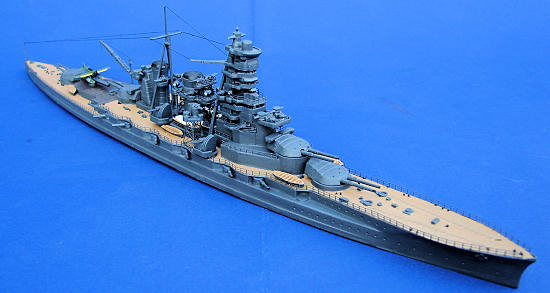 Kirishima's
keel was laid in Mitsubishi's Nagasaki yard on 17 March 1912. She was launched
about a year and a half later (1 December 1913) and transferred to Sasebo Naval
Arsenal for fitting out. After her completion on 19 April 1915, she served off
Japan, China and Korea's coasts during the First World War. After the war, she
alternated between being based in Japan and patrolling off Japanese ports. On 14
September 1922, she collided with a destroyer Fuji, causing minor damage to both
ships. Kirishina also assisted rescue efforts in the aftermath of the
devastating 1923 Great Kanto Earthquake, which destroyed most of Tokyo.
Kirishima's
keel was laid in Mitsubishi's Nagasaki yard on 17 March 1912. She was launched
about a year and a half later (1 December 1913) and transferred to Sasebo Naval
Arsenal for fitting out. After her completion on 19 April 1915, she served off
Japan, China and Korea's coasts during the First World War. After the war, she
alternated between being based in Japan and patrolling off Japanese ports. On 14
September 1922, she collided with a destroyer Fuji, causing minor damage to both
ships. Kirishina also assisted rescue efforts in the aftermath of the
devastating 1923 Great Kanto Earthquake, which destroyed most of Tokyo.
After being sent to the reserve fleet in December 1923, she received a refit
during 1924. Returning to the main fleet, the battlecruiser operated off China
for periods of time in 1925–1926, until she returned to reserve from 1927 to
1931 in preparation for a major reconstruction. Her superstructure was rebuilt,
and she received extensive upgrades to armour, propulsion, and waterline bulges.
After a period of fleet duty in the early 1930s, she underwent a two-year
reconstruction (1934–1936) to rebuild her as a Fast Battleship. This upgrade
improved her engine plant, redesigned the superstructure, lengthened the stern,
and enabled her to equip floatplanes.
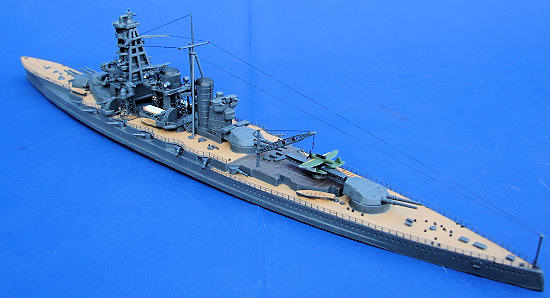 After
serving as a transport and support-ship during the Second Sino-Japanese War,
Kirishima escorted the aircraft carrier strikeforce bound for the attack on
Pearl Harbor in December 1941. Following the start of World War II, Kirishima
served as an escort during carrier attacks on Port Darwin and the Dutch East
Indies, Kirishima joined her sister ships in escorting naval sorties against
Ceylon. She once again served escort duty during the disastrous Battle of
Midway, before transferring to Truk Lagoon in preparation for operations against
American landings on Guadalcanal. After participating in the Battles of the
Eastern Solomons and Santa Cruz, Kirishima joined Hiei in a night attack on 13
November 1942. Following the loss of the latter on the evening of the 13th,
Kirishima subsequently engaged American battleships on the night of the
14th/15th. Although she managed to inflict significant damage on USS South
Dakota, she was in turn crippled by USS Washington. With her engines largely
disabled and listing heavily to starboard, Kirishima was abandoned in the early
morning of 15 November 1942. She capsized and sank at 03:25 with the loss of 212
of her crew.
After
serving as a transport and support-ship during the Second Sino-Japanese War,
Kirishima escorted the aircraft carrier strikeforce bound for the attack on
Pearl Harbor in December 1941. Following the start of World War II, Kirishima
served as an escort during carrier attacks on Port Darwin and the Dutch East
Indies, Kirishima joined her sister ships in escorting naval sorties against
Ceylon. She once again served escort duty during the disastrous Battle of
Midway, before transferring to Truk Lagoon in preparation for operations against
American landings on Guadalcanal. After participating in the Battles of the
Eastern Solomons and Santa Cruz, Kirishima joined Hiei in a night attack on 13
November 1942. Following the loss of the latter on the evening of the 13th,
Kirishima subsequently engaged American battleships on the night of the
14th/15th. Although she managed to inflict significant damage on USS South
Dakota, she was in turn crippled by USS Washington. With her engines largely
disabled and listing heavily to starboard, Kirishima was abandoned in the early
morning of 15 November 1942. She capsized and sank at 03:25 with the loss of 212
of her crew.
| THE KIT |
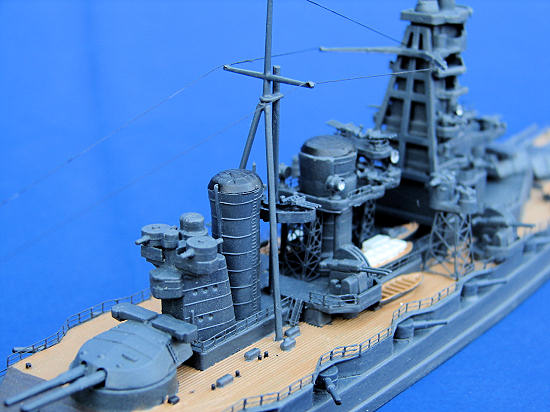 Molded in
gray plastic, the level of detail is good. No flash was noticed, even on the
smallest parts. The hull is one piece with the decks and basic superstructure
molded in place. I noticed that there are extra parts that will not be used, so
your spares box will feel batter at the end. A red waterline part is provided as
well as a rather heavy weight.
Molded in
gray plastic, the level of detail is good. No flash was noticed, even on the
smallest parts. The hull is one piece with the decks and basic superstructure
molded in place. I noticed that there are extra parts that will not be used, so
your spares box will feel batter at the end. A red waterline part is provided as
well as a rather heavy weight.
The instructions are a single sheet,
printed on both sides. The simple diagrams are more then sufficient to build the
kit and a top and side view are also provided.
| CONSTRUCTION |
Like most of my ship builds, I did it in subassemblies. Turrets, deck
structures as well as the distinctive Japanese "Pagoda" mast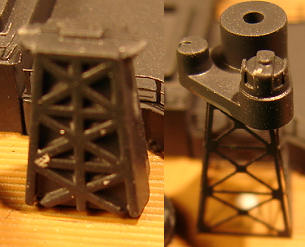 were all built off the hull and added later.
After painting, I added the p/e rails to the
superstructure decks. The smokestack and their distinctive girders were
installed next. I filled the holes for the kits rangefinder mounts and installed
the p/e ones in their place. After installing the turrets, I added the main deck
rails. The pagoda was completed, rails and all, and added to the hull. The last
parts added were the aircraft, aircraft crane and then the rigging was done.
were all built off the hull and added later.
After painting, I added the p/e rails to the
superstructure decks. The smokestack and their distinctive girders were
installed next. I filled the holes for the kits rangefinder mounts and installed
the p/e ones in their place. After installing the turrets, I added the main deck
rails. The pagoda was completed, rails and all, and added to the hull. The last
parts added were the aircraft, aircraft crane and then the rigging was done.
The Gold Medal Models "Japanese Battleship" p/e set is very nice. In this scale, care should be taken when folding the rangefinder mounts, smokestack girders and the aircraft catapult. Japanese BB rails are particular difficult due to the odd deck shapes. A good pair of mechanical dividers makes the job much easier.
| COLORS & MARKINGS |
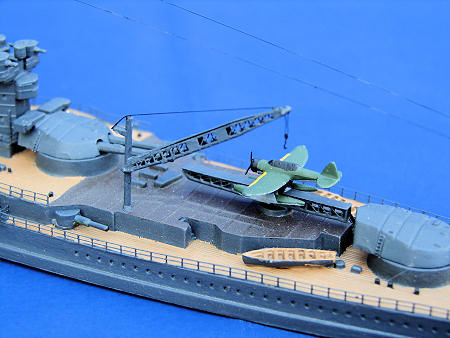 The
sprues were painted MM Dark Gray before any assembly was done. The main deck was
then brush painted MM Wood and the aircraft deck was painted German Bed/Brown.
No decals were used as they were missing from my kit.
The
sprues were painted MM Dark Gray before any assembly was done. The main deck was
then brush painted MM Wood and the aircraft deck was painted German Bed/Brown.
No decals were used as they were missing from my kit.
| CONCLUSIONS |
| REFERENCES |
Wikipedia for the history
Photos off the internet
August 2011
If you would like your product reviewed fairly and fairly quickly, please contact the editor or see other details in the Note to Contributors.